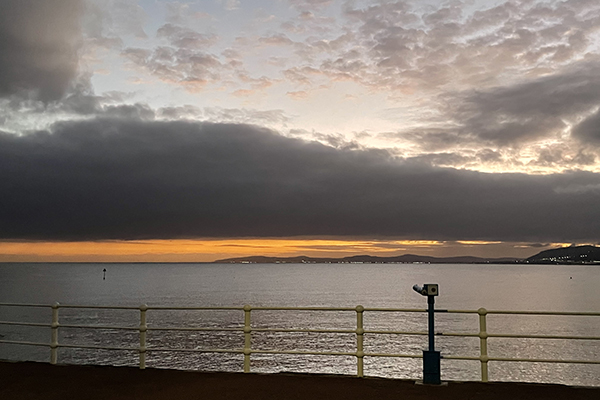The 1st SCAN canon netting session of the year took place Saturday and the target species were Dunlin. A previous recce, by Tom, had found good numbers roosting over the high tide just outside Beaumaris, Anglesey. Meeting at 08.15 to load the huge amount of gear required for a canon netting session we were soon heading across the Menai Strait via Robert Stephensons Britannia Bridge to meet up with the rest of the team.
Two small mesh nets were set about 100 metres apart as the sunrise above the surrounding hills. A glorious sight as the suns rays broke through the low cloud and illuminated the hillsides as they drop down to the sea.
Once the nets were set the long wait commenced. Some of the team went off looking for Brent Geese colour rings to read whilst the rest of us hung around the vehicles chatting until it was time to start moving into our designated positions. The spotting & firing team moved to where they could observe the nets and fire when birds were in the right position and it was safe to fire. Backstops were sent to either end of the beach to advise any members of the public what was happening whilst the rest of us (the lifting team) settled down to wait.
The lifting team usually can’t see the catching area so we’re kept updated of what was happening via walkie-talkie radio. It’s always a tense time. Are the nets in the right place? Will the birds turn up? Will something disturb the birds before we can fire the nets? ( usually a Peregrine!).
As the tide rose small numbers of Dunlin started moving onto the beach but not the large numbers seen during the recce. Nerves start setting in properly at this stage but a radio message from Steve saying another 400 Dunlin had arrived filled us with a bit more optimism. Unfortunately the birds weren’t in the right area so Claire was sent to do a bit of ‘twinkling’ to try and slowly and calmly get the birds to move slightly so they were in an area where we could catch them and, very importantly where it was safe to make the catch.
With radio instructions from Steve, who was watching from the firing position, she did this to great effect and soon we got the message that Steve was arming the firing box followed by the count down from three and suddenly we were up and running as the nets were fired.
The lifting team were first to their designated positions and the net was lifted away from the edge of the rising tide before the birds were covered with hessian coverings to keep them calm before being extracted and placed into keeping ready for ringing and processing. The birds would be roosting over high tide and wouldn’t be feeding anyway so keeping them dark, warm & calm in keeping cages isn’t taking up valuable feeding time during these short winter days.
 |
| Keeping cages |
 |
Small mesh net drying on the beach whilst birds are processed
It turned out to be a good catch with 1333 Dunlin (930 new birds and 403 retrap) processed along with 8 Ringed Plover and 2 Turnstone. The Ringed Plover and Turnstone were colour flagged as part of other long term monitoring projects. The Dunlin catch included a few foreign controls as well as at least two colour ringed birds from central Wales. Foreign controls included 4 from Sweden, 1from Poland and one from Norway! |
 |
| Polish control |
The size of the catch gave a number of trainees plenty of experience in ringing as well as ageing - Dunlin are fairly easy to age as juveniles have buff tipped coverts whilst adults are all white. Occasionally there’s a bird that has retained some juvenile feathers as well as having adult type and these can be more precisely aged. The majority of adults were aged as Euring 6 meaning they were are in at least their third calendar year. The juveniles were all Euring 5 being in their second calendar year and fledged last year. We had one bird that we could age as Euring 7 meaning it definitely was definitely in its third calendar year having fledged in 2020.
Photo below shows a good comparison between adult and juvenile Dunlin wings with the adult being the top bird.
 |
| Adult Dunlin above, juvenile below |
 |
| Dunlin Euring 7 |
The Ringed Plover and Turnstone were all colour flagged as part of other long term monitoring projects being carried out by SCAN. Colour ringing / flagging is a great study tool as it allows birders to report birds seen in the field whereas as a metal ring on such small birds are virtually impossible to read in the field. This provides even more data for researchers to work with.
 |
| Above & below: 2 colour ringed Dunlin from a project in mid-Wales controlled by SCAN |
A very long & tiring day but thoroughly enjoyable. I left home in the dark and got home in the dark!









































































